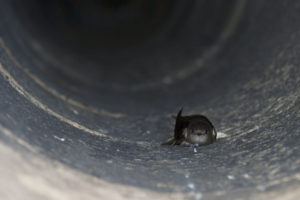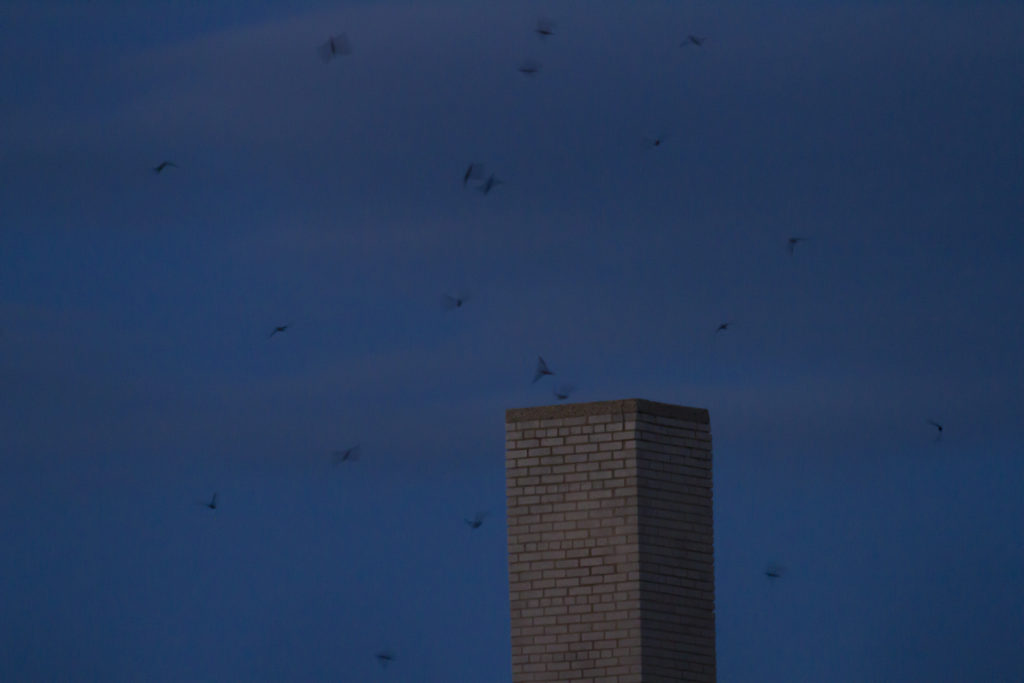
Chimney swift
I’ve been listening to chimney swifts chittering and “rattling” in our Nature Center chimney from my desk since the beginning of May. They’ve successfully nested in the chimney and raised babies in their tiny, stick nests. This chitter (food begging) has become a constant companion, and like hearing the din of your kids at home, I’ll miss them when they go – migrating to South America for the winter season.
This is the time of year when swifts start communally roosting at night, sometimes gathering in large groups numbering in the hundreds or thousands. At dusk, they will dive into the chimney and stay until morning. In cases where there are immense numbers, it’s like watching a funnel of birds pouring into the chimney. Once you’ve experienced this natural phenomenon, you’ll never forget it. Examples of this can bee seen online by visiting the Wisconsin Chimney Swift Working Group site: http://www.wiswifts.org/
Unfortunately, this unique bird is on the decline. We’re not sure why, but some possible reasons are due to the loss of habitat (chimneys are being torn down and no longer being built with changes in technology), and the widespread use of pesticides. More research is needed.
In light of this, there is a national movement called “Swift Night Out” where people can watch chimneys where swifts roost for the night. They count the number of swifts that go in and report their findings to eBird or their local coordinator. Green Bay has been doing this for six years now and they’ve even gotten Titletown Brewing to create a Swifts’ Night Ale in honor of the swift.
Kim Grveles, Department of Natural Resources assistant ornithologist and a member of the Wisconsin Chimney Swift Working Group says, “Chimney swifts are an important species in Wisconsin because they help keep flying insect populations in check. We need citizens’ help in counting the birds near them. In reporting that information to us, we can better understand and take steps to hopefully reverse the decline of chimney swifts.”
Tips on how and where to look for chimney swifts
I’ve heard many Chimney swifts flying over Washington Street in Two Rivers, feeding on insects during the day. This is a good place to look for old brick chimneys with easy viewing. They fly rapidly, often twisting from side to side, and have a high chittering call when in flight.
How to count swifts roosting: Pick a night in mid to late August when they are out of the nesting phase. Look for tall brick chimneys that are uncapped. Watch to see where swifts are feeding and congregating. Observe the roost starting about 30 minutes before sunset until 10 minutes after the last swift enters the chimney. Count (or estimate) the number of swifts as they enter the chimney. It’s useful to count in groups of five or 10 when they pour in to the chimney in a short period of time. Contact Nabak at Woodland Dunes Nature Center for a monitoring form and to turn in results: nancyn@woodlanddunes.org or 920-793-4007. It’s easy and you’ll help make a difference for this remarkable bird.
- Article and photos by Nancy Nabak, Communication Coordinator, Woodland Dunes Nature Center

Chimney swifts swarming before entering chimney for night
–
